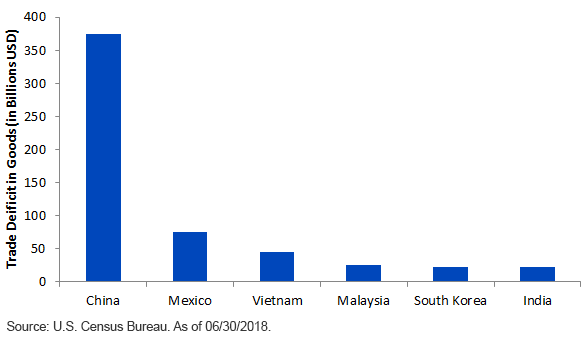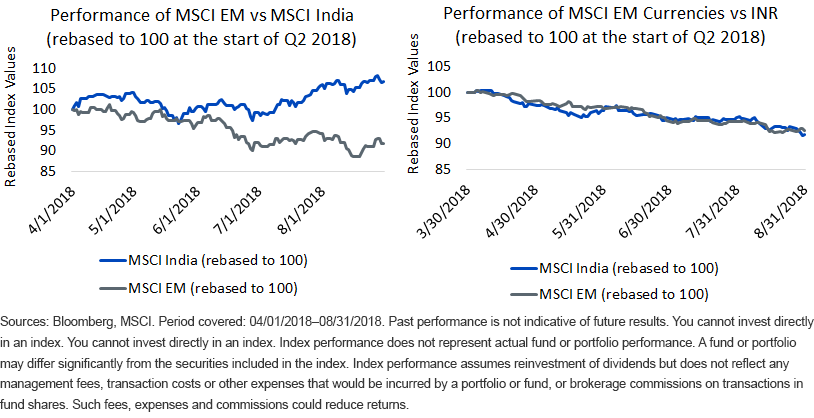Separating Good from Bad Emerging Market Exposure


As pioneers of Modern Alpha™ strategies and currency hedging, WisdomTree has been at the forefront of providing smarter exposure to investors. Our head of Research, Jeremy Schwartz, recently wrote about managing currency risk in our newly launched Emerging Market (EM) multifactor strategy. This comes at a time when EM currencies have been under immense pressure due to trade concerns, sanctions and a host of other global macro-related issues.
Should all EM exposures be painted with the same brush—and if not, what is the right way to separate good EM exposure from bad in the current environment?
Separating EM into Its Components
Most investors have treated EM like a monolith—a single asset class. However, individual countries do have a positive beta to the asset class, just like in any other region. In the European Union, for example, there are fundamental differences between the German and Italian economies. Similarly, there are fundamental differences between the Indian and Brazilian economies.
This is why, when it comes to the single biggest threat facing EM stocks right now—trade and geopolitics—we hear of certain countries like China and Turkey much more often than countries like India and South Korea.
When Washington looks into individual trade surpluses, they start with the chart below.
At a Chinese trade surplus of over $375 billion, Washington realizes that closing 10% of the total gap with China would be a much bigger victory than closing 100% of the gap with Malaysia, South Korea or especially India individually.1
Here I would clarify that not all Chinese equities face the brunt of a trade war, but investors should focus on sectors and companies that tap into China’s stellar internal growth, such as Information Technology, which is increasingly the focus of the new China economy, while staying away from traditional manufacturing and industrial companies.
2017 Trade Deficit of the U.S. for Goods Traded with Large EM Trading Partners

Currency Is Important
Whenever there is any negative sentiment about broad EM, currencies, which are almost entirely driven by global appetite (and macro factors such as inflation and rates), are the first to be impacted due to knee-jerk reactions from investors. In contrast, equities, which are in part driven by global risk appetite and in part by earnings and economic growth, can continue to do well.
Thus, EM currencies tend to move in a flock, driven by global risk appetite, while stocks can continue to be differentiated from currencies and can offer positive returns.
The right-hand chart below shows how the rupee mostly has been moving in lockstep with other EM currencies over the last quarter (since trade war concerns started escalating). At the same time, Indian equities (i.e., MSCI India), shown in the left-hand chart, have demonstrated massive divergence from broad EM equities (i.e., MSCI EM). Note that outperformance by Indian equities is even more interesting when you consider that it is in U.S. dollar terms and includes the currency drag of rupee depreciation over that period.

So, What’s the Best Way to Allocate in EM?
First, we believe a plain market cap-weighted exposure to EM does severe injustice to investor portfolios by under-weighting fast-growing countries that have a relatively small market capitalization, such as India. Here are two alternative ways to allocate to EM, while still limiting currency and country risk:
1. WisdomTree Emerging Markets Multifactor Fund (EMMF)
- Afterlaunching its multifactor approach in the U.S., WisdomTree recently launched EMMF, which dynamically hedges currency exposure to currencies showing weaker momentum. There are two aspects of this strategy that can make it appealing for investors looking for broader exposure to EM:
- Selecting stocks with the highest composite scores on fundamental factors such as value and quality along with technical factors such as momentum and lower correlations. This model is designed to add alpha by creating a portfolio with meaningful deviations from cap weighting while also having weights derived from volatility levels to manage volatility in the current market environment.
- Currency hedging overlay on EM currencies displaying weakening momentum. By using our dynamic approach, this strategy generally only hedges around 20% of the time, thereby keeping the cost of hedging lower compared to being hedged all the time.
- Overall: a multifactor exposure with a dynamic currency hedge in broad EM.
2. WisdomTree India Earnings Fund (EPI)
- For investors looking for specific exposure to the EM universe, we believe a smart exposure to Indian equities has a lot of upside. Launched in 2007, EPI was the first exchange-traded product in the U.S. with physical access to Indian equities. However, what makes it unique is its methodology, which again focuses on smarter stock selection rather than market cap weighting. Here are a few aspects that make EPI a smarter way to access Indian stocks:
- Selecting only profitable companies and weighting by their dollar net earnings at the time of rebalancing.
- An earnings-driven approach provides investors with exposure to companies that are profitable. Disciplined rebalancing to overweight companies generating higher earnings ensures lower valuation multiples, which is often a concern with Indian stocks. Historically, EPI has traded at a 15%–20% discount of price-to-earnings (P/E) ratios compared to MSCI India, while still delivering exposure to profit-generating companies only.2
- Overall: exposure to profitable companies within the world’s fastest-growing large economy.
EM as an asset class often earns bad press due to its lower performance concentrated in select sectors, regions or currencies. In my opinion, investors who actively seek out good EM exposure—and avoid bad EM exposure—can capture the long-term growth rates that EM has to offer.
1Source: U.S. Census Bureau, as of 06/30/18.
2Source: WisdomTree, as of 06/30/18.
Important Risks Related to this Article
EMMF:
Investing involves risk including possible loss of principal. Investments in non-U.S. securities involve political, regulatory, and economic risks that may not be present in U.S. securities. For example, foreign securities may be subject to risk of loss due to foreign currency fluctuations, political or economic instability, or geographic events that adversely impact issuers of foreign securities. Investments in securities and instruments traded in developing or emerging markets, or that provide exposure to such securities or markets, can involve additional risks relating to political, economic, or regulatory conditions not associated with investments in U.S. securities and instruments or investments in more developed international markets.
Derivatives used by the Fund to offset exposure to foreign currencies may not perform as intended. There can be no assurance that the Fund's hedging transactions will be effective. The value of an investment in the Fund could be significantly and negatively impacted if foreign currencies appreciate at the same time that the value of the Fund's equity holdings falls. While the Fund is actively managed, the Fund's investment process is expected to be heavily dependent on quantitative models and the models may not perform as intended.
EPI:
There are risks associated with investing, including possible loss of principal. Foreign investing involves special risks, such as risk of loss from currency fluctuation or political or economic uncertainty. This Fund focuses its investments in India, thereby increasing the impact of events and developments associated with the region, which can adversely affect performance. Investments in emerging, offshore or frontier markets such as India are generally less liquid and less efficient than investments in developed markets and are subject to additional risks, such as risks of adverse governmental regulation and intervention or political developments. As this Fund has a high concentration in some sectors, the Fund can be adversely affected by changes in those sectors. Due to the investment strategy of this Fund, it may make higher capital gain distributions than other ETFs. Please read the Fund’s prospectus for specific details regarding the Fund’s risk profile.


